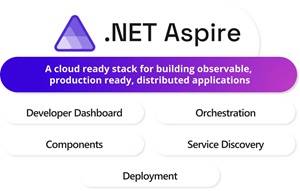News
Cloud-Focused .NET Aspire 9.1 Released
Along with .NET 10 Preview 1, Microsoft released .NET Aspire 9.1, the latest update to its opinionated, cloud-ready stack for building resilient, observable, and configurable cloud-native applications with .NET.
Microsoft has been heavily focusing on .NET Aspire among all of its developer tooling, and v9.1 shipped yesterday (Feb. 25), along with .NET 10 Preview 1.
 [Click on image for larger view.] .NET Aspire (source: Microsoft).
[Click on image for larger view.] .NET Aspire (source: Microsoft).
"We are excited to announce the release of .NET Aspire 9.1!" announced Maddy Montaquila, senior product manager. "This release includes several new features and quality of life improvements based on feedback from developers using .NET Aspire in production applications."
The release introduces several enhancements aimed at improving developer experience and application management. Notable updates include an improved onboarding experience with support for GitHub Codespaces and Dev Containers, allowing for seamless setup and development in cloud-based environments. The dashboard now features resource relationships, visually nesting related resources to clarify dependencies. Localization overrides enable users to set the dashboard language independently of browser settings, and advanced filtering options allow sorting resources by type, state, and health status. Expanded resource details provide deeper insights into configurations, including references and volume mount types. Additionally, developers can configure CORS for custom local domains, enhancing telemetry integration, and console logs now offer download options and ANSI color toggling for improved readability.
These updates collectively enhance monitoring, debugging, and resource visualization in cloud-native .NET applications.
Some key updates include:
- Improved Onboarding Experience
- GitHub Codespaces and Dev Containers Support: .NET Aspire 9.1 introduces templates compatible with GitHub Codespaces and Visual Studio Code Dev Containers, enabling seamless cloud-based development environments.
- Dashboard Enhancements
- Resource Relationships: The dashboard now visually represents parent-child relationships among resources, such as a PostgreSQL instance with multiple databases, enhancing clarity in resource management.
- Localization Overrides: Users can set the dashboard language independently of their browser settings, providing a more personalized experience.
- Advanced Filtering: New filters allow sorting resources by type, state, and health status, streamlining navigation and monitoring.
- Expanded Resource Details: The details pane now displays additional information, including references, back references, and volume mount types, offering deeper insights into resource configurations.
- Clear Logs and Telemetry: New options allow users to clear console logs, structured logs, traces, and metrics directly from the dashboard, facilitating a cleaner workspace during development and testing.
- Additional Features
- CORS Support for Custom Local Domains: Developers can configure Cross-Origin Resource Sharing (CORS) to permit the dashboard to receive telemetry from browser applications on custom local domains, facilitating integrated monitoring.
- Flexible Console Logs: The console log page now includes options to download logs for external analysis and to toggle ANSI color codes, improving readability and diagnostics.
- Improved Docker Integration: Enhancements in Docker support simplify containerized application development and deployment.
More information can be found in the company's "what's new" post.
About the Author
David Ramel is an editor and writer at Converge 360.